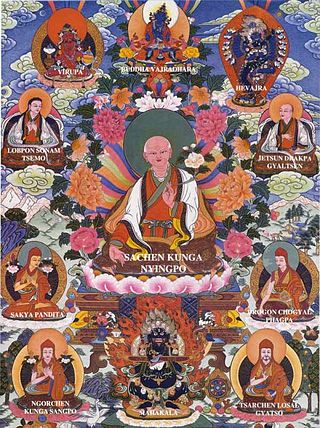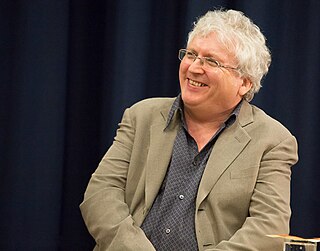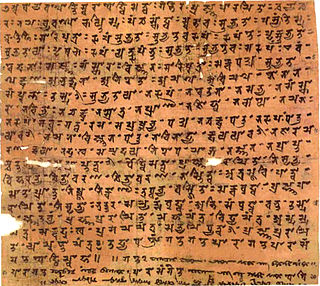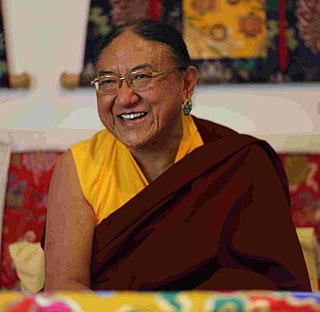
The Sakya school is one of four major schools of Tibetan Buddhism, the others being the Nyingma, Kagyu, and Gelug. It is one of the Red Hat Orders along with the Nyingma and Kagyu.

Drogön Chogyal Phagpa, was the fifth leader of the Sakya school of Tibetan Buddhism. He was also the first Imperial Preceptor of the Yuan dynasty and was concurrently named the director of the Bureau of Buddhist and Tibetan Affairs, serving during the reign of Kublai Khan.

Jamyang Khyentse Wangpo, also known by his tertön title, Pema Ösel Dongak Lingpa, was a teacher, scholar and tertön of 19th-century Tibet. He was a leading figure in the Rimé movement.

Sonam Tsemo, an important Tibetan sprititual leader and Buddhist scholar, was the second of the so-called Five Venerable Supreme Sakya Masters of Tibet, the founding fathers of the Sakya tradition.

Sakya PanditaKunga Gyeltsen was a Tibetan spiritual leader and Buddhist scholar and the fourth of the Five Sakya Forefathers. Künga Gyeltsen is generally known simply as Sakya Pandita, a title given to him in recognition of his scholarly achievements and knowledge of Sanskrit. He is held in the tradition to have been an emanation of Manjusri, the embodiment of the wisdom of all the Buddhas.

Sakya Monastery, also known as Pel Sakya, is a Buddhist monastery situated in Sa'gya Town (ས་སྐྱ་), Sa'gya County, about 127 kilometres (79 mi) west of Shigatse in the Tibet Autonomous Region, China. The monastery is considered as the seat of the Sakya school of Tibetan Buddhism.

Sakya Trizin is the traditional title of the head of the Sakya school of Tibetan Buddhism.
Namgyal Rinpoche, Karma Tenzin Dorje (1931–2003), born Leslie George Dawson in Toronto, Canada, was a Tibetan Buddhist lama in the Karma Kagyu tradition.

Sakya Tashi Ling is a monastery belonging to one of four Buddhist schools from Tibet, the Sakyapa tradition. It is an ancient order that follows the Tibetan spiritual leader and ancient king Sakya Trizin. The monastery is ruled by Lama Jamyang Tashi Dorje. It was built in 1905 by a family of "indians", called the Palau Novella which passed into the hands of the Buddhist community, Sakya Tashi Ling. They restored the building and installed a museum inside. It was re-established in July 1996, in the municipality of Olivella in the comarca of Garraf, Barcelona, Catalonia, Spain.
The Second Beru Khyentse, born Thupten Sherap is a lineage holder of the Karma Kagyu school of Tibetan Buddhism and the third reincarnation of Jamyang Khyentse Wangpo (1820–1892).

Ratna Vajra Rinpoche, is a Tibetan Buddhist teacher who served as the 42nd Sakya Trizin from 2017 to 2022, considered one of the highest qualified lineage masters of both the esoteric and exoteric traditions of Buddhist philosophy and meditation. He is a descendant of the famous Khon family in Tibet, which holds an unbroken lineage of great and famous masters for over a thousand years. He is the eldest son of the 41st Sakya Trizin Ngawang Kunga. He teaches Buddhism and travels extensively throughout Europe, Asia, Australia, New Zealand and North America. Ratna Vajra was enthroned as the head of the Sakya school on 9 March 2017. On 16 March 2022, the throne of the Sakya school was passed by Ratna Vajra to his younger brother Gyana Vajra, who became the 43rd Sakya Trizin.

Lama Jampa Thaye is a teacher of the Sakya and Karma Kagyu traditions of Tibetan Buddhism. He has been teaching for over 30 years and is the spiritual director of the Dechen organisation of Buddhist Centres. He is the author of several books on Tibetan Buddhism and has a PhD in Tibetan Religions from the University of Manchester. He is renowned for being one of the first Westerners who are authorised to transmit Vajrayana teachings.
Buddhists, predominantly from India, first actively disseminated their practices in Tibet from the 6th to the 9th centuries CE. During the Era of Fragmentation, Buddhism waned in Tibet, only to rise again in the 11th century. With the Mongol invasion of Tibet and the establishment of the Mongol Yuan dynasty (1271–1368) in China, Tibetan Buddhism spread beyond Tibet to Mongolia and China. From the 14th to the 20th centuries, Tibetan Buddhism was patronized by the Chinese Ming dynasty (1368–1644) and the Manchurian Qing dynasty (1644–1912) which ruled China.
Jetsunma Kushok Chimey Luding is a Buddhist teacher born in Tibet (1938). She is a Jetsunma. This title is comun when a woman was born in a traditional Tibetan family.
Yeshe Rinchen was a Tibetan Imperial Preceptor (Dishi) at the court of the Mongol-led Yuan dynasty. He hailed from Sakya, the foremost monastic regime in Tibet in this period, and held the title from 1286 to 1291.

Sanskrit Buddhist literature refers to Buddhist texts composed either in classical Sanskrit, in a register that has been called "Buddhist Hybrid Sanskrit", or a mixture of these two. Several non-Mahāyāna Nikāyas appear to have kept their canons in Sanskrit, the most prominent being the Sarvāstivāda school. Many Mahāyāna Sūtras and śāstras also survive in Buddhistic Sanskrit or in standard Sanskrit.

Although there were many householder-yogis in Tibet, monasticism was the foundation of Buddhism in Tibet. There were over 6,000 monasteries in Tibet. However, nearly all of these were ransacked and destroyed by Red Guards during the Cultural Revolution. Most of the major monasteries have been at least partially re-established, while many others remain in ruins.
Khön Könchok Gyalpo was the founder of the Sakya School of Tibetan Buddhism, and the founder of Sakya Monastery. Khön Könchok Gyalpo was born in Sa'gya, Tsang. He was a member of the Khön family, and his ancestry can be traced back to Khön Dorje Rinpoche, student of Padmasambhava. He followed his father and brother and learned doctrines of the Nyingma School at a young age, but studied newly translated Vajrayāna texts with Drogmi Shakya Yeshe later. Khön Könchok Gyalpo established Sakya Monastery in 1073, where the Sakya Tradition first developed. His son Khön Kunga Nyingpo was regarded as the first leader of Sakya, and Khön Könchok Gyalpo is known as the first Sakya Trizin.

Sakya Trizin Ngawang Kunga served as the 41st Sakya Trizin, the throne holder of the Sakya Lineage of Tibetan Buddhism, from his appointment in 1952 until his retirement in 2017. His religious name is Ngawang Kunga Tegchen Palbar Trinley Samphel Wangyi Gyalpo. After passing the throne of the Sakya lineage to his elder son Ratna Vajra Rinpoche who became the 42nd Sakya Trizin on 9 March 2017, he is now known as Kyabgon Gongma Trichen Rinpoche.
Khön clan of Sakya is a Tibetan clan and nobility originally based in Sa'gya. The clan traces its history to the time of Bod Chen Po. The Sakya Trizin of Sakya school was exclusively chosen from members of this clan. The current head of Khön clan is Gyana Vajra Rinpoche.











